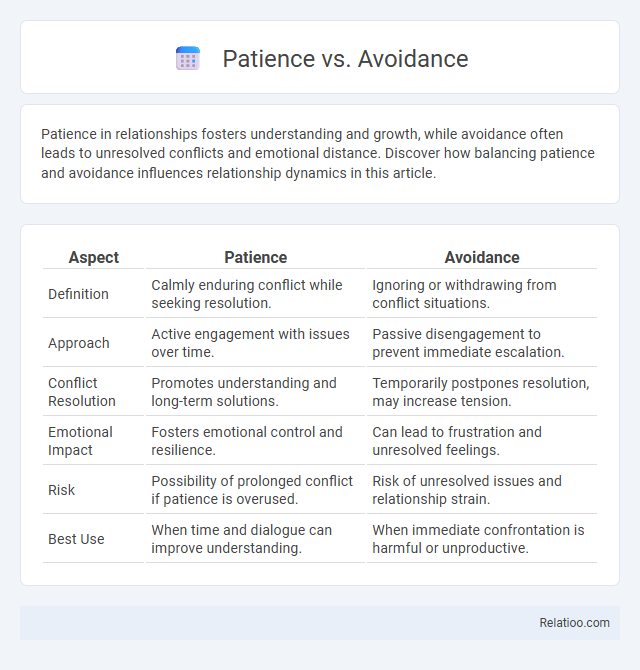Patience in relationships fosters understanding and growth, while avoidance often leads to unresolved conflicts and emotional distance. Discover how balancing patience and avoidance influences relationship dynamics in this article.
Table of Comparison
| Aspect | Patience | Avoidance |
|---|---|---|
| Definition | Calmly enduring conflict while seeking resolution. | Ignoring or withdrawing from conflict situations. |
| Approach | Active engagement with issues over time. | Passive disengagement to prevent immediate escalation. |
| Conflict Resolution | Promotes understanding and long-term solutions. | Temporarily postpones resolution, may increase tension. |
| Emotional Impact | Fosters emotional control and resilience. | Can lead to frustration and unresolved feelings. |
| Risk | Possibility of prolonged conflict if patience is overused. | Risk of unresolved issues and relationship strain. |
| Best Use | When time and dialogue can improve understanding. | When immediate confrontation is harmful or unproductive. |
Understanding Patience and Avoidance
Patience involves calmly enduring difficult situations or delays without frustration, allowing for thoughtful responses and emotional regulation. Avoidance, in contrast, is the tendency to evade or escape challenges or stressors, often leading to unresolved issues and increased anxiety. Understanding patience requires recognizing it as an active coping strategy that fosters resilience and problem-solving, whereas avoidance represents a passive defense mechanism that can hinder personal growth and emotional well-being.
Key Differences Between Patience and Avoidance
Patience involves enduring difficult situations calmly while maintaining a proactive attitude, whereas avoidance refers to deliberately ignoring or escaping problems to evade discomfort. Patience fosters emotional resilience and problem-solving, contrasting with avoidance's tendency to prolong issues and generate anxiety. Understanding these key differences highlights that patience leads to growth, while avoidance often hinders resolution.
Psychological Roots of Patience
Patience originates from emotional regulation and cognitive control, enabling individuals to tolerate delays or discomfort without stress. Unlike avoidance, which stems from fear or anxiety to evade negative experiences, patience involves conscious acceptance and resilience against impulsive reactions. Psychological research links patience to prefrontal cortex activity, facilitating self-control and the ability to delay gratification for long-term benefits.
The Triggers of Avoidance Behavior
Avoidance behavior often stems from triggers such as fear of failure, anxiety, or overwhelming stress, leading Your mind to sidestep challenging situations rather than confront them. This behavior contrasts with patience, which involves calmly enduring difficulties or delays without resorting to avoidance. Recognizing and addressing these avoidance triggers is essential for developing genuine patience and fostering personal growth.
Benefits of Cultivating Patience
Cultivating patience enhances emotional resilience, allowing you to navigate stress and frustration more effectively while avoiding impulsive decisions that often accompany avoidance behaviors. Unlike avoidance, which can delay solutions and increase anxiety, patience fosters a proactive mindset that supports long-term goal achievement and healthier relationships. Developing patience benefits your mental wellbeing by promoting mindfulness and enabling thoughtful responses to challenges.
Risks and Consequences of Avoidance
Avoidance often leads to unresolved conflicts and increased stress, negatively impacting your mental health and relationships. Unlike patience, which involves enduring challenges with understanding, avoidance can cause problems to escalate and create long-term emotional damage. Ignoring issues delays growth and can result in missed opportunities for resolution and personal development.
Patience in Decision Making
Patience in decision making fosters thoughtful evaluation by allowing time for comprehensive analysis and reducing impulsive errors. Unlike avoidance, which delays action without resolution, patience strategically balances reflection and timely decisions to optimize outcomes. This approach enhances problem-solving effectiveness by prioritizing deliberate consideration over hasty or evasive responses.
Avoidance and Its Impact on Growth
Avoidance often hinders personal growth by preventing you from confronting challenges and developing resilience. While patience allows for deliberate progress and learning, avoidance delays critical decision-making and stunts emotional maturity. Embracing patience rather than avoidance fosters a proactive mindset essential for overcoming obstacles and achieving long-term success.
Strategies to Transform Avoidance Into Patience
Transforming avoidance into patience requires recognizing the underlying fears or discomfort causing the avoidance behavior. You can practice mindfulness and gradual exposure to challenging situations, fostering tolerance and emotional regulation over time. Building resilience through consistent reflection and reframing negative thoughts supports the development of patient strategies in place of avoidance.
Real-Life Examples: Patience vs Avoidance
Patience involves actively enduring challenges or delays to achieve long-term goals, as seen when a student studies diligently for years to earn a degree despite setbacks. Avoidance, conversely, entails evading problems or decisions, such as ignoring mounting medical symptoms instead of seeking treatment. Real-life examples highlight that patience fosters growth and problem-solving, whereas avoidance often leads to exacerbated issues and missed opportunities.

Infographic: Patience vs Avoidance
 relatioo.com
relatioo.com